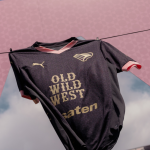
Stadium sandwiches as a collective ritual
Phenomenology of football eaten, between sausages and sauces
January 10th, 2024
The experience of a football match on TV is very different from a live one. Let's start with a platitude to try to get to the heart of the matter at hand, going beyond how exciting it is to hear the choruses and choreographies of the fans, how great it is to shout at the top of one's lungs and hug the stranger sitting in the seat next to you, as if he were the friend of a lifetime. Gathering with friends and girlfriends at home to watch the big match of the day is a panacea at any time of the year, but the main difference between live and televised football is perhaps in the pre-match rituals, in that feeling at the stadium of being part of a liturgy attended by thousands of people. All the elements are there: the processions to the stadium and the people who celebrate these rituals, to whom we entrust superstitions and traditions that cannot be altered in any way. Among these moments, the stop at the sandwich stalls is one of the most important stages of the pre-match, capable of transforming the wait into a feast, into a gastronomic fair in which to begin to feel the thermometer of the evening, to gather the latest defeatist predictions or to feel part of a single, great, collective moment.
While take-away pizza or burgers eaten directly on the couch always have their appeal, sandwich makers make the pre-match at the stadium unique because they turn it into a sensory experience. From the comfort of your sofa, you can enter the stadium from home, getting a preview of what's going on in the changing rooms and the tunnel, from which we see the players emerge and get into the match mood immediately. For their part in the kiosks lies the beauty and the ability to prolong the relationship with the outside of the stadiums, to look at them from the outside like cathedrals and feel their grandeur. The view of the San Siro from Piazzale Angelo Moratti is among the most evocative experiences one can have as a fan, and it is there that dozens of paninari have been delivering sandwiches dripping with sauces for decades. At that point, the hubbub in front of the plates and staplers stimulates the senses, as does the trail of perfume flowing through the streets leading to the turnstiles and the taste of the sandwiches, which are not asked to be gourmet, but to be the same as always, and perhaps bring good luck.
The mystique surrounding the paninari is also linked to the fact that these venues completely turn the perspective away from the game. The centre of the experience is not inside the pitch but outside, from football played to 'football eaten', a term used by the sauce company Heinz in its latest campaign. The project launched during the festive season by Heinz tells a good story about the role of paninari within the football world and the bond that is created between food and football. Through the stories of three protagonists, it is told how the kiosks are part of stadium life and at the same time are a world apart, with the people behind the counters who for years, in some cases even decades, have been present outside the stadium at every match, always in the same pitch watching generations of fans enter the stadium without ever attending the matches.
The kiosk, like the sauce, thus becomes the element that helps to give flavor to everything else, and it is easy to enter the metaphor through the stories of Mauro, Ruggiero and Sofia, who for once manage to watch the match, the one that until then they could only imagine thanks to the choirs and shouts rising from the stands. During the 90 minutes, as the pitch empties, from outside football becomes a tale of sounds, and these protagonists, alone, waiting for the fans to come out again, have learned to recognize the progress of the match and the scorers.
While the stadium scoreboards mark and mark time, the collective ritual that is celebrated over sauces and condiments lives in suspended time, there is no time for a ketchup and mayonnaise sandwich. Be it early, postponement, midweek or midday match, spring or winter, the sandwich surpasses all conventions, all good dietary resolutions, and the pre-match sandwich is merely the preamble to the post-match sandwich, which will console for defeat or celebrate a great victory.
















